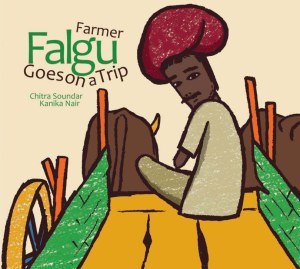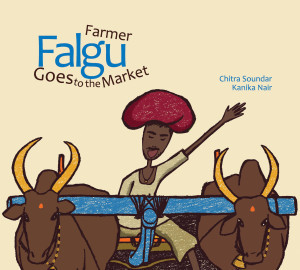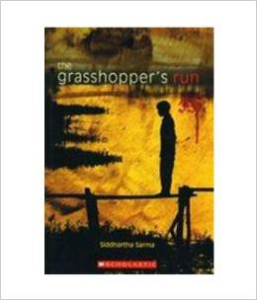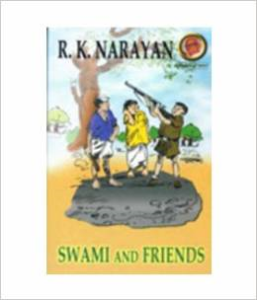Chitra Soundar's Blog, page 9
August 3, 2015
Books in My Life
My reading list is growing. With new prize longlists and shortlists and books of friends, books from India, books that I read long ago that I want to read again, books I want to learn from – so many books.
I’ve got an accumulated stack of books that have been signed for me – friends, eminent friends and celebrity authors (not the kind of celebrity authors who were celebrities before they wrote a book, the kind that are celebrity to me because they write amazing books.)
So I decided I have to organise my reading, keep track of what I’m reading, perhaps recommend some books to others and I looked around for a reading journal. There are a few available in the stationery section. But I didn’t fancy giving up my reading time to update my entire history of reading and my current TO-READ list.
 Then I looked for online journals – to keep track of the books. I checked one called LibraryThing – but didn’t like it as much and they also charge after 200 books. Then of course I had a Shelfari account because they are part of Amazon and I had a GoodReads account. Choices are good that we can choose what we want. But they force you to try them out and choose – takes longer to decide.
Then I looked for online journals – to keep track of the books. I checked one called LibraryThing – but didn’t like it as much and they also charge after 200 books. Then of course I had a Shelfari account because they are part of Amazon and I had a GoodReads account. Choices are good that we can choose what we want. But they force you to try them out and choose – takes longer to decide.
But while researching this – I found an useful article about other book related sites and I’ve fallen in love with BookLikes. I think BookLikes is great for librarians, classroom book blogs and personal book blogs too. But as in life and in this post, I digress. For the purpose of what I came to tell you, I’ll keep it to GoodReads. I’ll be telling you all about my BookLikes adventure soon.
At this moment I’m still on GoodReads and I uploaded my entire list of books – To Read, Already Read to GoodReads. Because I uploaded 8 to 10 years worth of reading history – GoodReads assumed I had read all of them in 2015. I wish!
Just like I’m obsessed about front-facing shampoo bottles, order of keys in my keyrings, wearing matching jewelry and such, I’m also obsessed about being honest about the “Date I finished Reading” on every book.
So that’s a lot of books to update. But I started on it bravely. As I went down the list thinking about when I would have read it – it evoked memories, emotions and emotional memories.
As I read down the list of books to mark their date, my past began to unfold in the form of a book list. I could make out the patterns of my emotional life, what happened when along with the dates for the books.
Oh I read that one when I moved into my new flat
That one was when I was sad with a breakup and wanted a Pick me Up
This one was during the course I did with Andy Stanton at Faber
I couldn’t believe how these books have been transplated into my memory along with life-changing events.
I remember, a few years ago, giving up writing for 6 months due to one of those yo-yo relationships – you know when someone can’t make up their mind about you. I completely broke down because that person was my first reader.
More than life, it affected my writing.  That’s when I picked up this amazing book. And here I am with more books written and published and still writing. It really freed the writer within me.
That’s when I picked up this amazing book. And here I am with more books written and published and still writing. It really freed the writer within me.
From Faraway tree that made me tell stories to The Curious Incident of the Dog in the Nighttime that showed me possibilities, the list of books that is weaved into my life is very long.
Books do so many things to people. Some movies do too. But I think books stay with you longer because they force you to imagine. The nerve cells in your brain fuse and expand trying to figure out the words on the printed page. They go to your long-term memory and emotional memory. (Those who watched Inside Out know what I’m talking about! What a movie, that would stay with me for sure. I digress again.)
When I started updating the month and year of reading a book I realized some books I read almost as soon as I bought them. Some books I bought on release day. Some books were left on their own on the bookshelf. They call out to me sometimes – “you’ve to read me!”.
I remember not just what I was feeling or experiencing when I read these books, but also what happened after. Did my life change?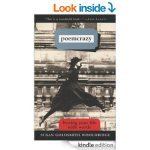
I found this book in a NY bookstore near Wall Street nestled among the writing books. What a joy it brought me. I spent the weekend walking the riverside and writing poems – they might not be good poems, but they had a bit of me inside them.
More recently I read Gangleader for a Day, We are Completely Beside Ourselves, Us Minus Mum and Elizabeth is Missing and so many more. I loved Luminaries and I loved the silly Red Eyes at Night by Michael Morpugo.
Each time, it changes life either in the core or in the edges. Like a real experience does. That’s what I like about reading.
I watched Kite Runner in the cinema and I cried for nights. Then against my own advice I read the book. I cried for weeks. I couldn’t stop thinking about that boy. I was living his pain and I was devastated. I had always liked kites as a child. I made them at home and took them up to my terrace. But this story has now imprinted itself into the word KITE in my brain. Every time I see a kite, I think of Kite Runner.
I have a new stack of books now. Signed books from YALC, signed books from book launches and in a frenzy of catching up on authors I loved reading in the last two years. That’s what happened when I took stock – I realized I loved a book and then I checked for more books by the same author and ended up buying more than I have space for – in shelves and in life.
Well, a girl’s gotta do, what she’s gotta do. READ!
So do you have a catalog of all the books you’ve read? Do you think of them interlinked with life? Or is your life on a parallel track to the train of books that rush past you?
Tell me if a book changed your life. Tell me if it has folded a memory like a dog-ear in a book for looking back. Tell me if it has changed your outlook to life, how you see others, how you see yourself. Is it a window to you or a mirror or both? Is it a doorway to other lives, other worlds, other perspectives?
And I leave you with this wonderful video showing the power of books. Go on, I know you’ll love it.
July 21, 2015
In the UnLikely Event – Part 2 of 2
Have you read Part 1 of this story? If not, find it here.
We were listening to Charlie Higson and Arabella Weir talk about their books. No connection to their books, but they obviously were good friends. Charlie told the story about how he scared his kid writing the zombie series. I’ve heard it before in a smaller setting three years ago – but it was still funny. He did the voices too this time. And of course he said he possibly couldn’t work on Doctor Who if they asked, because he was busy with Dr. Jekyll and Mr. Hyde series for the television. (so there, I tied one loose end from the last post, didn’t I?).
 I loved that book as a child. I think subtly it taught me about people could be both black and white – sometimes as a young person it is hard to assimilate what you see around you unless someone put it in a book.
I loved that book as a child. I think subtly it taught me about people could be both black and white – sometimes as a young person it is hard to assimilate what you see around you unless someone put it in a book.
Anyway, there we are in the front row, tweeting and checking tweets and hoping Charlie or Arabella won’t mind us looking at our phones, right under their noses (and skirts). And I saw a tweet say – the Judy Blume / Patrick Ness conversation was in the first floor.
First floor where all those dressed up people had turned up in droves, ten times more than the first day? First floor where big sets for SyFy TV was setup and first floor where people who were afraid of sunshine moved from one merchandise shop to the other? This was Big Bang Theory coming alive in the worst possible way.
I tweeted back – but that’s not the YALC floor. Are you sure?
Patrick Ness tweeted back adding Judy Blume to the conversation – Yes, it is in on the first floor, take it from me, I am interviewing her and I’m sure.
Okay then, we had to make our way downstairs, through throngs of people who would be doing the same. Michael J Fox was already in session in that big hall. It was running late. Yes, we knew it would run late, because people didn’t know where to queue for the show – so they interrupted every session on Day 2 to tell us where to queue to see Michael J Fox. Everyone except those who wanted to see him knew where to go.
Christina and I decided we were going to try hardest to get to the front row seats. She said let’s a scot show you how it’s done. I laughed. I’m from India. Crowd, getting seats, jostling in sweat, I can do it. This is what I’ve trained for all my life. Leave it with me. Well, we hoped.
When the big shutters were opened and the crowd rolled out, we waited ready to pounce into the hall. Perhaps like Spiderman hauling ourselves into the stage with spider glue.
That’s when it happened. Judy and Patrick (see how familiar I’m getting, next I would be cooking lunch for them), came through. We were literally at the door. No choice, they had to go past us. Judy gave us the biggest smile and hello. We hello-ed back. I hollowed out. Then Patrick and then I thanked Patrick for tweeting back.
Then the mad rush to get seats. Ha, ha, never challenge an Indian person about getting seats. Go to India and see how creative we are with hand-kerchiefs. I found three seats for the three conference-teers. Right in front of Judy. She couldn’t miss seeing us.
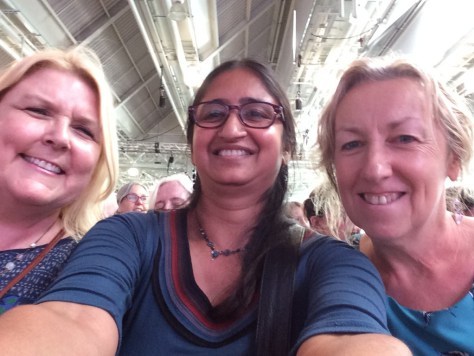
Anyway, enough of the trailer before the actual movie. The actual interview was fabulous. She was warm, funny, direct, frank and genuine. It was brilliant, she referred to her husband George often and he was in the front row seat too and he asked a question that perhaps many wanted to ask.
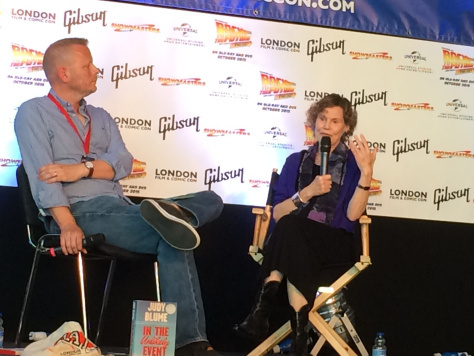
Patrick was brilliant – you can genuinely see the affection and warmth between the two people and of course UKYA authors had turned out in droves and many fans.
I had told myself I wasn’t standing in queues for signing. I hadn’t bought a single book or picked up a pamphlet or a button or a sticker so far. But I decided I was going to stand in the queue and meet Judy Blume and read her book and read all her books – how come I never read any of her younger books?
I had brought money in the Unlikely Event I had to buy a book and I did buy her book (and more…, more on that later) and stood in the queue. A very friendly person perhaps from her publishers took pictures on our phones for all of us. So that was good. I have this Unlikely Moment caught on camera.
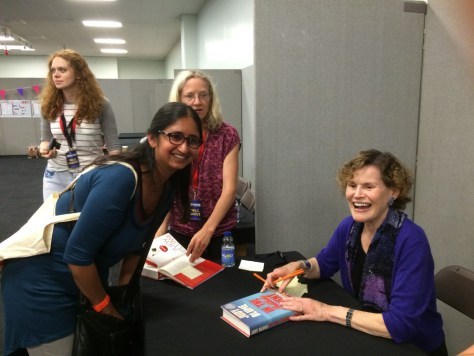
Judy did recognize me from the encounter at the entrance and from making inevitable eye-contact from the stage and she asked – Have We Met Before? She was amazing – even if everyone knows it, I am going to say it.
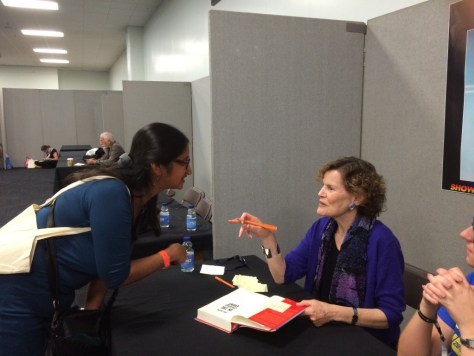
The funny thing is – if I told anyone at work or anywhere different to my book circle, people won’t understand the celebrity status of the writers we revere. Malorie Blackman, Chris Riddell, Patrick Ness, Tanya Landman and so many people I know, I’ve met, I have made friends with – they are celebrities to the children of many generations, celebr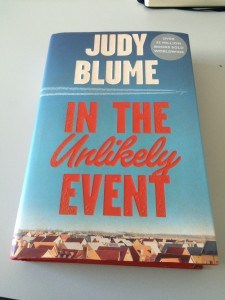 ities to other writers – but they are not YouTube stars or Hollywood Icons or recognizable BAFTA names or Heads of State or anything. They should be – we would have a better education policy.
ities to other writers – but they are not YouTube stars or Hollywood Icons or recognizable BAFTA names or Heads of State or anything. They should be – we would have a better education policy.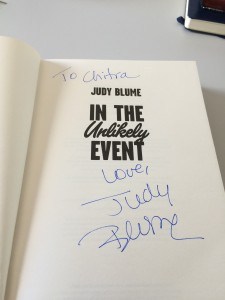
So this moment of meeting Judy Blume and Chris Riddell and hanging out with award-winning writers after Day 2 of the conference – is special to me and those like me. Who cares if others don’t understand? Isn’t that what Comic Con is all about – we love this stuff and we get out once a year to celebrate this and who cares what you think why we are dressing up? I get it I think.
So if you thought meeting Judy Blume and Chris Riddell and listening to Malorie Blackman and two days of hanging out with now-best buddies would be the end of it – you’d be disappointed.
Again thanks to Facebook – a librarian friend said there’s a fringe party after the event at the pub- are you going? I checked it out – I saw some friendly faces in the Facebook event. So I asked if I could go and of course the friendly folks that YA authors are said Of course.

So after Day 2 at YALC we headed to the pub. All the glitterati of the YA author scene were inside the venue in a party. We hung out in the pub until slowly people trickled in.
I met some wonderful authors, some I’ve met before a long time ago and some only on Facebook. I got to meet Anthony McGowan again and he introduced me to Caroline Green and then Jo Cotterill was there, Lucy Coats without her Cleo headgear, Lee Wetherly, Liz Kessler, Sarah Mussi, Lydia Syson and loads of other people.
 Tanya Landman had come down just for the YALC party and she had promised to sign my book (well her book, I have a copy, er, you know what I mean). We ended up talking about diversity in books and jolly good she said she would help with any initiatives I might kickstart. So watch this space for that.
Tanya Landman had come down just for the YALC party and she had promised to sign my book (well her book, I have a copy, er, you know what I mean). We ended up talking about diversity in books and jolly good she said she would help with any initiatives I might kickstart. So watch this space for that.
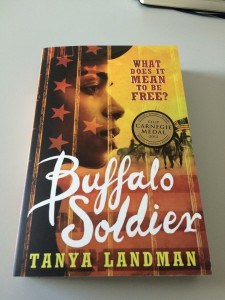

They talked and I listened most of the time. It was totally Unlikely. Here were a bunch of award-winning writers, with amazing talent and track-record and I was in the same space-time continuum with them. How Unlikely was that?
It was a weekend of Unlikely Events and one I wouldn’t forget. I’ve made new friends, forged new connections, learnt from the speakers and more importantly brushed shoulders with the masters of today’s UK YA scene. An Unlikely Blessing for sure.
Oh btw, I chickened out of Day 3 of YALC and I’m writing this. So the introvert did assert herself again – but I’m glad she hid away for Day 1 and 2.
July 19, 2015
In the Unlikely Event – Part 1 of 2
This entire weekend and the days before that have been unlikely. I’m not a writer of Young Adult (YA) books. I read some YA – but definitely not horror or science fiction or fantasy. Therefore it was highly unlikely I was going to attend the YALC – the Young Adult Literature Conference especially inside the London Comic Con Height of Unlikely from where I stood.
But that’s what happened. In a moment of utter boredom at work, I was googling something when I found that the YALC was in its second year, setup by the amazing Malorie Blackman in 2014 as part of her laureateship. I didn’t go in its inaugural year as I didn’t think myself either as a YA reader or as a YA writer. Loads of my friends from Facebook and beyond did go (they are YA writers) and they loved it.
So like a typical Young Adult or in normal speak teen, I didn’t fancy getting left out this time. I wanted to be part of the buzz too. I was going to go – there was nothing planned for that weekend anyway. So I booked.
Normally I book things and don’t go to everything I booked – simply because  I’m an introvert first and a social next. Yeah, yeah, you won’t know it when you see me. That’s me dressed up as an extrovert, like Dr. Jekyll and Mr. Hyde (Oops, sorry, Charlie Higson, I’ll talk about it later).
I’m an introvert first and a social next. Yeah, yeah, you won’t know it when you see me. That’s me dressed up as an extrovert, like Dr. Jekyll and Mr. Hyde (Oops, sorry, Charlie Higson, I’ll talk about it later).
I’ve been scouring Facebook to find others I knew who were going this year. Other than the speakers of course because you know, speakers are different. They’d be on stage and they’d have an entourage and signing queues. I found no one from my immediate comfort zone – that was going. Hmm, as Monday came the ping-pong of I’m going, I’m not going started in my head. I still hadn’t told anyone I was going.
By Wednesday, I was almost pinging on “I’m Not Going” when I saw a Facebook post that Christina Banach and Candy Gourlay were going to be at the Barbican Library to celebrate the launch of Moira McPartlin’s new book Ways of the Doomed.
Barbican Libray – I had always wanted to go back there. I live so close to this library and I work very very close to this library – I thought maybe I would go to the launch.
 But I would be gate-crashing. But it is a launch. Anyone can go and buy a book. You don’t need to know Moira. Candy knows me – so she would introduce me. So the argument went on in my head the whole day – I went to the Facebook page and said Going. Then Not Going. Then Going again… I finally changed it to Going at 6 pm that evening, printed out directions from London Wall to Barbican – which is not very tricky at all. And I set out.
But I would be gate-crashing. But it is a launch. Anyone can go and buy a book. You don’t need to know Moira. Candy knows me – so she would introduce me. So the argument went on in my head the whole day – I went to the Facebook page and said Going. Then Not Going. Then Going again… I finally changed it to Going at 6 pm that evening, printed out directions from London Wall to Barbican – which is not very tricky at all. And I set out.
When I went there, I found it was a book launch, in a library. Okay, I’ve been to events like this before. I can manage. Yes, I found Christina and rudely interrupted her chat with her friends. And I clung on to her. Then I waved to Candy and Moira McPartlin smiled and asked people to sit in the front and I sat down.
It was a brilliant launch – both Candy and Moira were funny, warm, honest and funny (did I say funny?).
Wine, some more SCBWI people who know me from Facebook and buying of the book and signing of the book and then Moira invited all of us to the pub when the library closed.
More SCBWI people like Peter, Jenny and more time with Candy and YALC came up quite often. Moira, Christina and I were all going. Yes, I finally confessed I had a weekend pass. Gold was it? In any case it was orange in colour. So we agreed to meet up, and stay together. Phew! Now I was going. I had committed. But I also had friends to connect with.
When the time came to get down at Olympia and come face to face with a snaking queue of Comic Con goers I panicked again. YALC – not this queue, said one of the organisers, go around. First I relaxed – okay YALC queue might be shorter, maybe a different building and all. Little did I know.
Around the building meant more queues to witness – more people dressed up. More people perhaps seeing sunshine for the first time since the previous Comic Con (I’m going to leave that description there, Lee Weatherly. If I wrote everything I told you yesterday, I might be sued.)
I was almost ready to type – Something came up, go ahead. I won’t be coming to YALC as a text to Christina and Moira. But I got a text from them – we are in the queue, come around.
Anyway, after a near-panic attack and a lot of advice on Facebook from Jo Cotterill and others to keep calm and carry on, I got inside the building. Entered Level 1 – freaked out with lots of Comic Con merchandise and more sun-starved men and some women and I rushed to Level 2 and slowly relaxed.

More of a book floor. More stalls of books (and some Comic Con stalls too). Spotted some friendly faces, found my friends. Bought myself an exorbitantly priced bottle of water and tea and it all began to unfold.
The three of us glued ourselves to the first row seats, where the speakers could make eye-contact and didn’t get up until the evening. Trust me, I’m an introvert. Even if I was in the front row seat.
I found myself listening to authors I had heard children speak about in schools – Darren Shan,  Derek Landy – people who write scary stuff, horror and fantasy and all mixed up.
Derek Landy – people who write scary stuff, horror and fantasy and all mixed up.
What was I doing here? I don’t read horror or write horror. I am not scared, I am just not that interested. It’s not my thing. The sound operator perfectly projected my boredom like this.
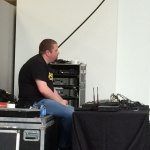 But it was fascinating to listen as a writer to the process, how they think about hunting down and killing characters. I know kids love it. For me this would be so similar to gaming but with all the imagination and levels in your head. That’s the best thing about books, isn’t it?
But it was fascinating to listen as a writer to the process, how they think about hunting down and killing characters. I know kids love it. For me this would be so similar to gaming but with all the imagination and levels in your head. That’s the best thing about books, isn’t it?
Now the ping-pong for the next day started – should I come back? Do I really want to sit through stuff that I won’t ever write about or read? This event is for fans – I felt as if I was an imposter. I wasn’t a fan. I can’t talk about this stuff with any authority. I don’t dress up as characters. I barely dress up as myself most days.
Did I go to the Cosplay party after Day 1 – you’re joking right? Especially Harry Potter themed – I have to confess, I’ve only read one paragraph of the first book. I would be more of an imposter if I did go. I want to read it – but there’s such big books.
But the next day had less paranormal and more closer to normal – if you think there is something called normal for teenagers. But Malorie Blackman would be there. More authors I know and I’ve rea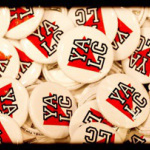 d. And of course the big event – Judy Blume and Patrick Ness in conversation.
d. And of course the big event – Judy Blume and Patrick Ness in conversation.
Anyway, as usual comrades in conference, Christina and Moira kept asking – you’re not coming then? Oh go on then, I’ll come. But I won’t come at 9 am like a fangirl. I’ll come to my first event to see Malorie at 12:30. Although Christina and Moira said I made a mistake by missing the first panel by young writers. Oh well. Trade-off for a morning of clearing my work, getting some writing done and lunch before I headed to Olympia again.
The story changes track here. It was a fabulous second day. Great speakers, fun interviews. I enjoyed the entire programme. And we were as usu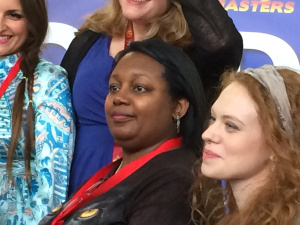 al seated in the front row where the official photographer wished he could be. We took some amazing pictures of the stage.
al seated in the front row where the official photographer wished he could be. We took some amazing pictures of the stage.
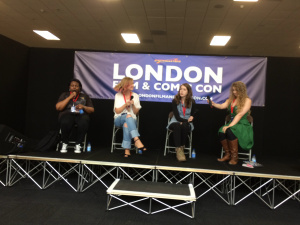
I was tweeting all day with #YALC and engaged with so many people. Made a school visit connection, met a twitter-friend and librarian in person who has invited me to her school.
And now it turned Unlikely. Chris Riddell was in the building. Wow! Fantastic! Even the bookshop wa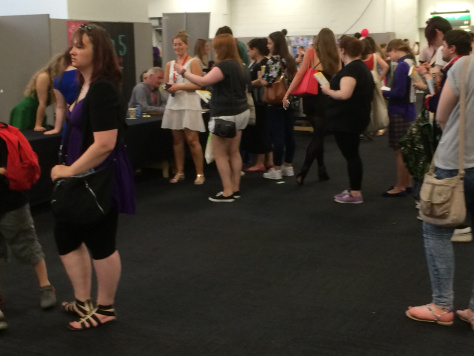 s surprised. Oops! The official bookseller had not stocked his books because no one knew he was going to come. What a brilliant laureate and person he was. He drew individual pictures for each person who wanted to meet him. How lucky those folks were. I got a book signed – big mistake.
s surprised. Oops! The official bookseller had not stocked his books because no one knew he was going to come. What a brilliant laureate and person he was. He drew individual pictures for each person who wanted to meet him. How lucky those folks were. I got a book signed – big mistake. 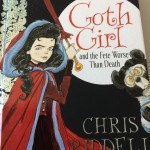
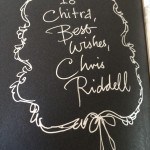 So I didn’t get a drawing that could go on my wall. I should have asked for a picture too – but I chickened out. I did talk to him about Prague and its spires and its Gothic architecture and he told me he felt the same. Right behind me was Holly Smalle waiting and the pressure to leave Chris Riddell in celebrity hands was high
So I didn’t get a drawing that could go on my wall. I should have asked for a picture too – but I chickened out. I did talk to him about Prague and its spires and its Gothic architecture and he told me he felt the same. Right behind me was Holly Smalle waiting and the pressure to leave Chris Riddell in celebrity hands was high 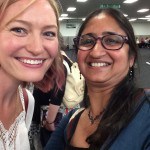 – so I walked away holding my book close.
– so I walked away holding my book close.
Well I skipped over something very important between tweeting all day and meeting Chris Riddell.
 The Unlikely Event of my meeting with Judy Blume (And Patrick Ness). I coined a new term too – BlumeNess© (All rights reserved). I’m going to have to write another blog post about that.
The Unlikely Event of my meeting with Judy Blume (And Patrick Ness). I coined a new term too – BlumeNess© (All rights reserved). I’m going to have to write another blog post about that.
And of course about an after-after-party at Hand and Flower with some YA luminaries. That’s for the next instalment too because I’d be here all weekend writing about that.
Read Part 2 here.
July 13, 2015
What do I do when I’m not writing?
I’m not a full-time writer. I still can’t afford to live on my writing income. In fact many writers are in that position nowadays. But I’ve always been writing while I was working ever since I sent my first unsolicited manuscript out in 2002. The first 3 days of the week, I write only for an hour or so in the mornings. Then comes the creative part of the week – Thursday to Sunday.  But what does that mean? Do I lock myself inside the attic room of a tower and type away on my antique typewriter until the takeaway man rings the doorbell?
But what does that mean? Do I lock myself inside the attic room of a tower and type away on my antique typewriter until the takeaway man rings the doorbell?
Nope – no attic, no tower, no antique typewriter and definitely not the takeaway. Much too fussy for takeaway.
Take the case of a professional racer like Lewis Hamilton – he says he never drives cars when he is not working. He rides a bike (not the pedal one of course). So as a writer what would I do with all the time I have every week for 4 days? My colleagues from my day job think I languish in the garden, enjoy elaborate lunches and go to the theatre most days.
Nope, no garden, no elaborate lunches and not a lot of theatre for sure.
My first priority is always the current projects – if I am in the middle of a book that is contracted, or a magazine article or editing a proposal, that’s what I would spend my mornings on. But sometimes I do get distracted and work on something completely speculative and then force myself to come back to the work on hand.
Then I start on preparation for school visits, updating the website, blogging like I’m doing now, creating additional activities and lesson plans for my books. It’s good to keep them updated and be prepared for the next visit. My motto – Always Be Prepared. I was a girl guide once, and well worth the training.
Of course I won’t have all of it to do on the same day. Some days are just writing days, some days are just extra-curricular work days.
But when the contracted projects have been sent away for someone to review or edit, when there is nothing new to do on my extra-curricular tasks – how do I spend my time?
Firstly just because I don’t have a contract on hand, doesn’t mean I stop writing. I’m always working on something – either a new idea or tweaking an old story, doing creative writing exercises, creating funny characters using a game called Character Relay, thinking up odd titles and first lines and scribbling haiku verses.
I have a notebook like what school children call a rough notebook. I write all sorts of things in it – from What-if scenarios to funny poems about the man I saw in the bus or how the clouds changed shape when I went into work. I don’t censor myself when I write in this notebook. I scratch out, I rewrite, I draw, I write messy and I storyboard. As long as the idea gets captured and I create some sparks in the creative nerves of my brains, I’m happy.
So when I’m not writing, I am doing a lot of other things.
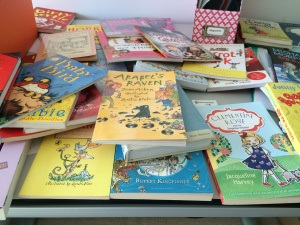 Like all writers, I read. I read lots of different books in many different modes – sometimes it’s a grownup book from the Booker shortlist on the kindle, sometimes a stack of picture books in the library and perhaps a sit-down with a collection of poems. The one thing I’m still reluctant to try – audio books.
Like all writers, I read. I read lots of different books in many different modes – sometimes it’s a grownup book from the Booker shortlist on the kindle, sometimes a stack of picture books in the library and perhaps a sit-down with a collection of poems. The one thing I’m still reluctant to try – audio books.
Very often reading stimulates and triggers a new idea. Sometimes a puzzle piece falls into place about a plot problem or a technique of writing or a character that needed the extra something. Then of course I race to my notebook to jot ideas down, to take down notes and such.
But some days the reading is hard. Could be because the mind is distracted, or there is a low point in the writing and I couldn’t bear to read a masterpiece that would push me into the abyss even deeper. So I have other distractions.
I doodle stuff – from robots to faces to houses to weird-looking cars and ambulance trucks. I colour them in too when I want to play with my sketch pens.
I do zen tangle patterns – I create boxes of design in black and white and in colour. 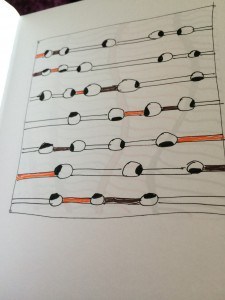 It calms my mind, focuses me on the design in front of me and makes me feel better when I see some of my own artwork.
It calms my mind, focuses me on the design in front of me and makes me feel better when I see some of my own artwork.
I watch birds – I was always a big fan of small birds. I used to stand in front of the huge small bird display at Natural History Museum for hours. I bought a pair of binoculars and a bird identifying poster a few years ago – but I dropped the binoculars and broke it. Recently after watching an urban birding segment on BBC – I decided I was going to find, listen to and watch birds in my neighbourhood. So I reinvested in a pair of binoculars. 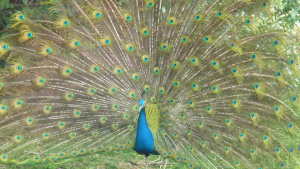 I diligently record every bird – even the innumerable blackbirds, magpies and crows I see and record their calls and try to memorise the sounds.
I diligently record every bird – even the innumerable blackbirds, magpies and crows I see and record their calls and try to memorise the sounds.
I cook – I love cooking all sorts of vegetarian food, bake small cakes and I dream of baking good bread.  I cook comfort food when I’m feeling low, I experiment when I find some amazing ingredient in the supermarket and try out new salads or soups because I love one-pot cooking. The dream is to write a comfort cook book sometime in my lifetime. But I don’t think I’m big on measuring ingredients – so like my sister says, how can anyone follow your recipe?
I cook comfort food when I’m feeling low, I experiment when I find some amazing ingredient in the supermarket and try out new salads or soups because I love one-pot cooking. The dream is to write a comfort cook book sometime in my lifetime. But I don’t think I’m big on measuring ingredients – so like my sister says, how can anyone follow your recipe?
I am going to admit two things that would make you gasp. I love ironing clothes while watching the telly and of course I do watch telly when I’m not pressing clothes too.  Oh dear, watching telly, isn’t that a bad thing? Well anything is okay in moderation and bad in excess, I reckon. Even ironing. But there are some awesome independent productions, 2-part and 4-part drama that is being produced in the UK now that it would be bad to miss out.
Oh dear, watching telly, isn’t that a bad thing? Well anything is okay in moderation and bad in excess, I reckon. Even ironing. But there are some awesome independent productions, 2-part and 4-part drama that is being produced in the UK now that it would be bad to miss out.
As I have mentioned before in earlier blog posts, I don’t really write well in the afternoons and evenings. So I try and take a break from writing and visit museums, meet friends and meet with family after lunch. In any case visiting family or friends before noon is too rude, isn’t it?
But writing does not always involve writing. You have to live life, watch people walk past, listen to people saying funny things or sad things, learn the name of a flower or a tree or a bird.  You have to fly kites, chase flying umbrella and embarrass your nephew in front of his nursery classmates.
You have to fly kites, chase flying umbrella and embarrass your nephew in front of his nursery classmates.
It’s also about looking into yourself and learning how to express the emotions you’re feeling now and perhaps the emotions of the past – a sad event in the past, a moment of celebration, a disappointment. All of living is fodder for the writing. But living it alone is not enough – I have to remember it and record it for later use.
My belief is Life Doesn’t Frighten Me, borrowing from Maya Angelou’s words.
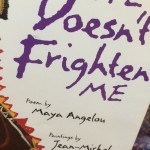
A wise person once said, because writing comes from inside the writer’s head, via the lens of the writer’s experience and from the imagination that has been enriched with myths, legends, stories, history, life, current affairs and so much more. Therefore the writer has to constantly fill the well with all sorts of stuff – hoping the quiet time, the time when you go for a walk, when you look at an elephant in the clouds, when you listen to music or dance to a new song, the time when you don’t write – will mulch the stuff into material – stuff dreams are made of, stuff imagination is made of.
If you want to write, don’t forget to live, reflect, observe, notice and of course write.
July 6, 2015
11 Ideas to Make Reading the Centre of Your Universe
As a kid I read a lot and as an adult I still read a lot. No one had to tell me reading was fun. But I think I missed out so many different things that could have enhanced my reading.
Couple of years ago, I started doing school visits, told stories to children and of course met some creative, craft-loving, singing-dancing mums and aunts and grandparents who inspired me to make reading absolutely more fun than anything else.
So here are some ideas on how to make books, stories and reading the centre of your universe.
Idea #1 – Read together. Read with voices, read with noises. Sing songs, dance to the verse and celebrate the words. Reading together doesn’t have to be aloud all the time. It could be as cosy as each person in the family from grandmother to toddler picking a place on the sofa or on the floor or under the dining table (as I used to) and read at the same time. Adults can’t just say reading is fun. Show the kids that reading is fun.
Here are some tips and great examples of reading aloud.
http://www.booktrust.org.uk/books/chi...
Idea #2 – Don’t judge the reading choice. I used to read newspapers, the Reader’s Digest, English textbooks of older kids with stories in them, comic books and magazines – both children’s and family magazines. Don’t force your children or yourself just to read motivational books, non-fiction, school assessment books or what’s useful for school.
Let them decide what they like. Some kids like non-fiction and some like stories. Some like comics only. All reading is good reading. Perhaps your kid plays cricket, find some books on the sport, find histories and biographies on the internet and print them out for them. Ask them to make a book about the sport.
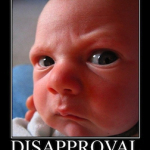 Don’t frown upon their choices in bookstores and libraries. Don’t check the price of storybooks and compare it to an encyclopedia. It’s like comparing the price of soap to the price of mangoes. Those two exist for two different reasons and we want them in different measures in our lives. No reading is wasted.
Don’t frown upon their choices in bookstores and libraries. Don’t check the price of storybooks and compare it to an encyclopedia. It’s like comparing the price of soap to the price of mangoes. Those two exist for two different reasons and we want them in different measures in our lives. No reading is wasted.
Stories are blueprints for life. Fiction allows children to read about someone else who has a similar problem or a different problem they have never seen before. When the character in the story has the same problem as the reader, the story equips the child to question their situation, shows them how to approach it or how not to. When the character in the story has a different problem than the child, it teaches empathy.
Here is a study by the UK government which emphasizes that reading for pleasure has far-reaching benefits.
Idea #3 – If your child is excited about a book, find songs to go with the book. Whether they are Bollywood tunes or nursery rhymes or pop music – ask them to explore. My storytelling coach used to encourage us to find songs for every story we want to tell. It’s a great way to celebrate the story and integrate it with other aspects of life.
Here is a list of books that have music as an integral part.
Here is a list of songs that encourage reading.
http://www.songsforteaching.com/readingencouragement.htm
Idea #4 – If you read a book together, draw and paint scenes together. How about mosaic art? 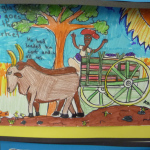
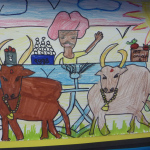
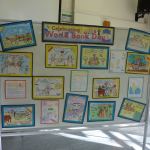 How about a home exhibition of all paintings all of you have done that are connected to the books you read. Invite aunties and uncles, grandparents and neighbours and create an art gallery visit.
How about a home exhibition of all paintings all of you have done that are connected to the books you read. Invite aunties and uncles, grandparents and neighbours and create an art gallery visit.
Perhaps you can create a pininterest board of all your drawings and artwork too.
Idea #5 – Crafts. I was always bad at crafts. Correction – I’m still bad at doing crafts. But I still try and attempt. I’m never going to have an art installation in Trafalgar Square – but my family would still think I’m the next Tracy Emin. So, be brave. Try it out.
The Internet and YouTube are filled with arts and crafts activity about every imaginable topic. So when I wanted to create a craft activity for my Farmer Falgu books – I found an ice-cream stick bullock-cart craft video. How cool. One school watched the video and created tens of bullock-carts for World Book Day.
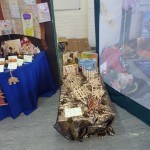
Here are some great videos of craft activities.
https://www.youtube.com/results?search_query=children+craft+activities+
Find a craft that matches the book. Be it a kite, a house, perhaps clay modeling of the animals, stickman if you are into Julia Donaldson. True for older kids and teenagers too.
Idea #6 – Movie nights – read great books that have been made into movies and follow it up with a movie night. Whether Bollywood or BBC Films, there is a treasure trove available. Some movies have been made more than once. Imagine the discussion at the dinner table – children would know if the movie justified the book or was better or was nowhere near it. Talk about if the character they had imagined matched the actor on screen.
Timeout has created a of fabulous movies that were adapted from children’s books.
http://www.timeout.com/new-york-kids/movies/best-kid-movies-adapted-from-childrens-books
And this is an exhaustive list of all movies made from children’s books.
https://en.wikipedia.org/wiki/List_of_children’s_books_made_into_feature_films
Idea #7 – Connect current affairs and history to the books you’re reading. If you read Enid Blyton and Tintin now, it would be a bit dated around some things. Some things that people said and did 50 years ago might not be polite now. Bring it up – talk about it.
Check out some hot topics and related books here. http://www.thechildrensbookreview.com...
Ask the children if they see today things that happen that might not be polite in the future. Children are wise in an innocent way. They would want a better world if you asked them about it and of course they are the ones who could make it happen. So create leaders of your brood. Show them how to make their own way.
That actually wants me to talk about science fiction – what was science fiction in the 1920s – read them now and see if some of it has become a reality. Similarly read today’s science fiction and think about what’s the probability of these new ideas becoming a reality.
Here is a list of inventions inspired by science fiction.
Here is another less serious list.
Now, historical fiction is a different type of fun. Imagine the stories set during historical times. What an opportunity to get grandparents involved in conversations about when they were young people and the stories they saw and how they relate to the books you’re reading.
I found this amazing list – but I would love to get suggestions on books set in India’s past, for children.
http://www.bookworm4kids.com/Historic...
What about the cultural scene when grandparents were kids? How does that measure up now?
Idea #8 – Animation adventures can be borne out of reading fun picture books or even chapter books. How about introducing your children to free tools to animate. They can draw and create animations – whether they write a script for their own book or a book they read or animate a book review – what a wonderful way to learn animation.
Here are some lists of animation ideas and resources.
http://domain.me/best-free-animation-software-for-children/
http://www.teachingideas.co.uk/ict/animationideas.htm
Are you hooked too? Then here are some grownup tools.
https://www.graphite.org/blog/16-websites-and-apps-for-making-videos-and-animation
Idea #9 – Blog about the books you read. There are great websites which request children to review books. Of course there are various competitions every year for which long-lists and shortlists are announced. Encourage your children to shadow the awards, review books they read, recommend books to their friends.
Here are some tips to start a book blog.
http://www.booktrust.org.uk/books/teenagers/writing-tips/tips-for-starting-a-book-blog/
http://www.theguardian.com/childrens-books-site/2014/dec/29/how-to-start-a-book-blog
Of course if you don’t want a blog of your own and want to contribute to a public blog, try this.
Idea #10 – Create a lending library manned by your little ones. Whether you invite neighbours and family to come and borrow or just for the immediate family – it is a great way to teach responsibility too. Children can arrange books, catalog them, review them, post recommendation notes and of course lend books out and chase out delayed returns.
Here is an idea of how to create a home library.
http://www.playingbythebook.net/2015/01/22/7-ways-to-set-up-and-run-a-childrens-book-group/
Idea #11 – Take a book like Diary of the Wimpy Kid – and ask your children to create a diary of their lives in the same design. How cool would that be? All they need is a blank notebook or a diary with lots of space to draw and write.
Perhaps they can develop an infographic about the book. Here are some free tools to create an infographic.
http://www.creativebloq.com/infographic/tools-2131971
I could go on and on and on. Try out all of them or some of them – make books and stories the centre of your family’s universe. Have fun. Come back and tell me which ideas worked and how it worked.
June 30, 2015
The Third Chutney
As a kid I grew up a big dose of stories – especially traditional tales, witty stories of tricksters and wise tales of Mulla Nassruddin and Tenali Raman and Raja Birbal.
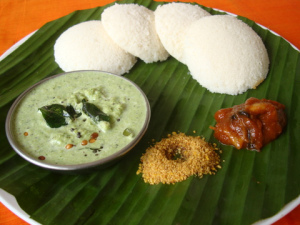 Stories were like the third chutney served with my hot idlies – stories were in the recipes, at the dinner-table and in the air.
Stories were like the third chutney served with my hot idlies – stories were in the recipes, at the dinner-table and in the air.
Most proverbs and advice were delivered in parables. For example, whenever my mum or grandmother wanted to advice me on self-help and doing things on my own, I would hear this story.
“There was once a man who was very devoted to God. But he was very poor. So one day he went to God and asked to become the next lottery winner. God appeared before him and granted him the wish. The man returned the next day after the results were announced. He was not the winner. There was no one outside his door offering a lot of money. He accused God of cheating. God appeared promptly and told him that at the least, the man should have bought a lottery ticket if he had wanted to win.”
I have never forgotten that lesson and my friends know that I’m averse to asking for help. I’d rather do it myself than ask for help. As a girl who grew up in 70s India, it was an advice ahead of its time and stood me in good stead.
There are more stories and fables that warned me about greedy people, about the wisdom of honesty and the joy of giving even if you had only little. One such story that stuck to me was the lake of milk. This is a story that transcends time and accurately depicts human behavior at its worst – when we have to survive, would we eat our young?
In a kingdom that used to be rich, famine struck. People lost crops, and their livelihoods and their livestock. Eventually some were really poor. A wise man said the famine has been caused by people who had no good intentions and if the people couldn’t change their ways, the famine would last forever.
The king was troubled by this. He wanted to believe that his people were not selfish and greedy. So he invited his people to donate a jug of milk for the poor people in their town. He cleared out a huge man-made lake and asked people to pour their jug of milk that night.
The milk deposit was planned for the night. People stood in queues with a jug. In the morning, when the king came to inspect he found a full pool. But filled with water. Everyone had assumed his jug of water wouldn’t be noticed in a pond of milk. Alas, no one had brought any milk to share.
The people were ashamed at their own selfishness and they didn’t need the king to emphasise this. The people gathered to share and to donate what they had with others thereby ending the famine of kindness in their hearts.
I never checked if these stories were from India or abroad. I read voraciously, listened to stories and joined in after dinner reminiscing of family stories.
One such story that stuck with me was the story of the camel and its master. 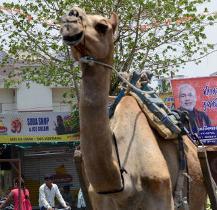 Camels are clever animals and I always have a soft spot for them – next only to giraffes and elephants. When I was six and I went to Delhi, I saw my first camel on the street. Coming from the south, used to seeing cows and elephants on the streets, seeing a camel was so different. I loved their shape, their quietness and their angry calls.
Camels are clever animals and I always have a soft spot for them – next only to giraffes and elephants. When I was six and I went to Delhi, I saw my first camel on the street. Coming from the south, used to seeing cows and elephants on the streets, seeing a camel was so different. I loved their shape, their quietness and their angry calls.
I had read so many Mulla Nassurdin stories that camels were part of my staple diet. Couple of years ago, I decided to retell a camel story that demonstrates the cleverness of camel. And then I sent it off to a publisher I work with in the US.
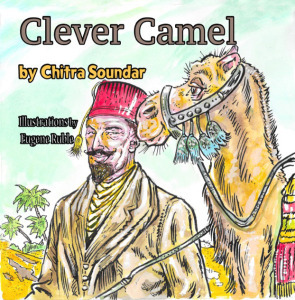 And here it is – the finished product illustrated by Eugene Ruble – the story of Clever Camel right from the deserts of the middle-east.
And here it is – the finished product illustrated by Eugene Ruble – the story of Clever Camel right from the deserts of the middle-east.
In this story the camel is a trickster and even though it is the underdog, it turns the table on its master.
If you love stories about animals – especially stories featuring Anansi or the Brer Rabbit, you would love this.
You can buy the book here from my website and all copies would be signed. If you want me to come to your school or library to tell the story, then check out the School & Library Visits page.
If you like retellings of folktale, do check out my story website http://thestorytrain.blogspot.co.uk/.
June 7, 2015
Who Let the Dogs Out?
It’s noisy – no I am not in the middle of a market right now.
Inside my head characters are talking, ideas are jumping up and down like over-excited dogs and characters are talking, arguing, laughing and making jokes inside my head.

Am I going crazy? Hold your horses, chief. I’m not going crazy.
This happens frequently.
What? Frequently? That means it is symptom of crazy!
Hmm, not really! At least not clinically insane. I’m bit crazy by many definitions anyway.
My head gets noisy when I don’t get sufficient time to spend on my writing. It could be because my day job is busier than normal or when I have too many external engagements or when I’m busy with family commitments and often watch TV instead of having a quiet evening.
It always happens when I don’t get 3-4 hours in the morning just for myself.
Usually I don’t write much in the afternoon – the afternoon hours are dead for my writing. My mind is too lazy and sluggish and sleepy. Evenings are too distracting – for one, I get very hungry by 6 pm and I am focussed on cooking dinner and eating.
I’m a morning person in all sense of the word. I prefer doing most of my important tasks in the morning. Whether it is going to the gym, writing a letter, preparing for my workshops, packing a suitcase. That means the time before 11 am is very expensive – too many things compete with my writing.
I prefer to write in the mornings – when I worked full-time I had to get up at 4 am and wrote until 7 am. Even now, on the days when I don’t go into work or the days when I don’t have school visits, I prefer to be up before 6 am to get the maximum out of my mornings.
But I digress from my critical condition – the noise in my head. The noise comes from cramming up a lot – like reading, little ideas into my phone app, scribbling notes, reading my plotting cards – but not having the time to ponder, thing, mulch and mince the words.
Sometimes I get an idea and would scratch it up in a notebook or type it into my favourite app into my phone – Evernote. That idea would start running around inside my head like a little dog chasing a squirrel. The only way the idea would quieten down is to try and write down some thoughts – not the story itself – but usually a storyboard or some plot diagrams or some scribbles.
When I don’t get the time to sit down and think through the idea, then of course the dog starts whining and then barking and like any dog that is cooped up inside for long, wants to be let out.
Sometimes when dogs are barking inside my head, and I am stuck in work meetings, this is what I do to quieten them – they calm down for a bit – but not for long.
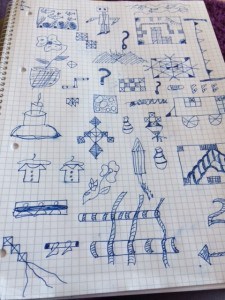
Then as the days go by, more dogs join and then it turn into a hullaballoo. Then I start singing this song.
Another big reason for the noise in the head is reading other books. Reading is so important for every writer – I read all sorts of fiction and non-fiction and of course my friends’ books and books on the award list and so on.
When I read something that touches me or when I read a wonderful page of prose or characterisation or a poem that strikes a chord, I’m inspired to write a piece in response. So the more I read, the more my desire to try a new piece of writing. That adds more barking dogs to the mayhem in my head.

So what do I do now? Well I need to find a few mornings soon and start as early as I can (that normally means I am not sociable after 8 pm at night – I need to hit the bed by 9:30 pm) and during summer – getting up in the morning is a joy. But going to bed at night while the sunlight is still fighting the dark forces of the night is not so easy.
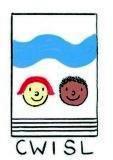
I’ll be at the Shoutsouth Creative Writing Festival with other CWISL authors this coming week (Find out more at http://www.shoutsouth.org.uk/) and my first day of uninterrupted writing is at least 10 days away.
Let’s hope I can quieten the dogs and dabble in some ideas, play with stories and rearrange words before being carted off to a loony bin.
May 7, 2015
A Dollop of Drama with Alice Fernbank
I’m so excited! No it’s not just the elections. Speaking of which, did you cast your vote yet?
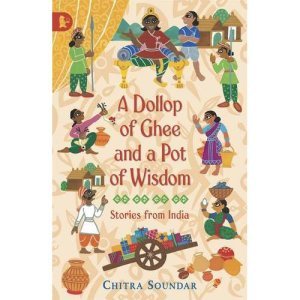 Alice Fernbank and I have been working on a new drama project based on A Dollop of Ghee and a Pot of Wisdom ever since I visited Cranford Park Academy where the kids were keen to dramatize it.
Alice Fernbank and I have been working on a new drama project based on A Dollop of Ghee and a Pot of Wisdom ever since I visited Cranford Park Academy where the kids were keen to dramatize it.
I met Alice in a masterclass with storyteller extraordinaire Jan Blake. Alice and I hit it off rightaway and though we told markedly different stories, we liked each others style. Our easy collaboration 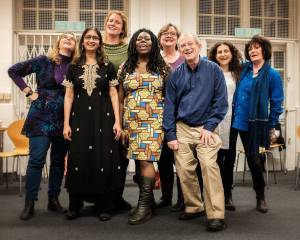 came to life when we had to mimic a scene without talking and we had a hilarious time doing it. And Jan called me Born to be a Clown! Really? Me?
came to life when we had to mimic a scene without talking and we had a hilarious time doing it. And Jan called me Born to be a Clown! Really? Me?
One thing led to another, we talked, we discussed, we dreamt and then we got another one of our masterclass friends Greg McCormick involved too.
A Dollop of Drama was born for real – A workshop to bring to life the characters and stories in the book A Dollop of Ghee and a Pot of Wisdom (Walker Books, UK). The story makes speaking, reading, talking and of course interpreting of written language so much fun. I love Veera and Suku and their irreverent sense of humour and my readers always have told me they want to have similar adventures.
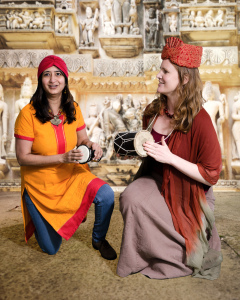 There you go – now you can. We planned the workshop for KS2 where we could bring the book into the schools, teach children how to create and bring a character to life, read and speak dialogue and match it with their body language too.
There you go – now you can. We planned the workshop for KS2 where we could bring the book into the schools, teach children how to create and bring a character to life, read and speak dialogue and match it with their body language too.
Greg then kindly offered to take pictures of us playing the part. We dressed up as Veera and Suku and the people of Himtuk, we made costumes, we made paper swords, we enacted scenes, we fell on the floor in a heap laughing at our own antics – while Greg was patiently setting up the lighting and camera angles.
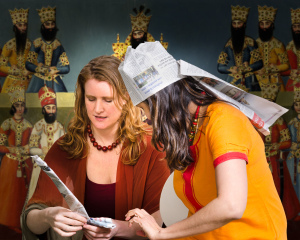 On this 7th day of May in the year 2015, we launched the workshops.
On this 7th day of May in the year 2015, we launched the workshops.
You can now bring us into your schools to work with your KS2 children. Imagine children getting fired up to read a book so they could play a part in the drama workshop, imagine them reading and talking dialogue and interpreting the words into action and body language. Every English and Drama teacher’s dream come true. But then literacy is always more than just English, isn’t it? Reading prescription to election manifestos, literacy in primary schools is literacy for life.
Interested? Want to know more? Check out the details here and get in touch.
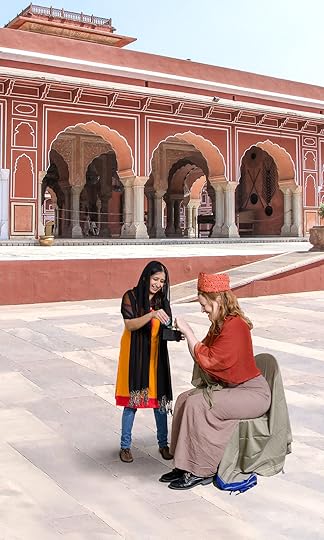
DSC_6394 comp-2
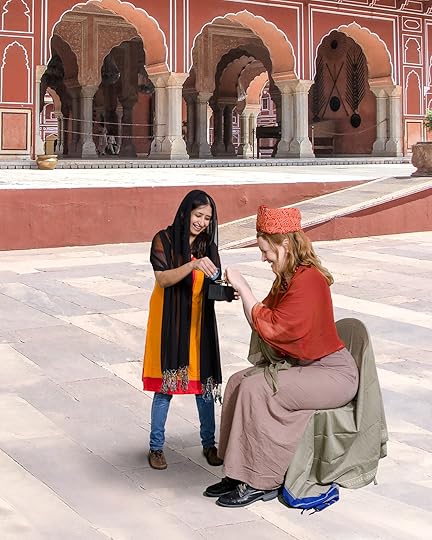
DSC_6394 comp-3
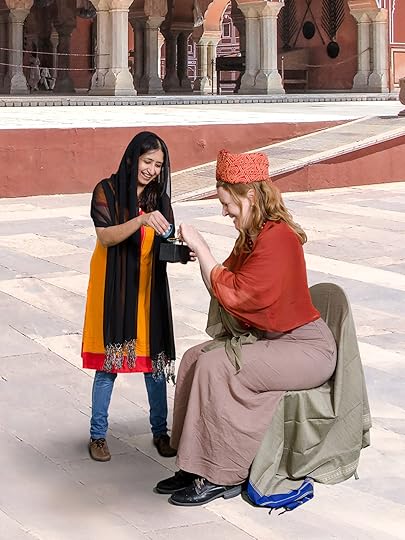
DSC_6394 comp

DSC_6403comp

DSC_6418 comp
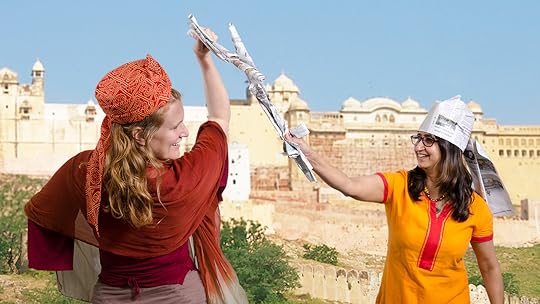
DSC_6484 edited
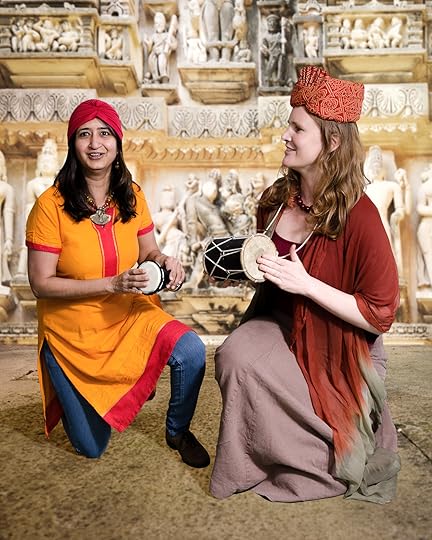
drum2

DSC_6484 edited

DSC_6394 comp

DSC_6418 comp bird
April 24, 2015
Children’s Books from India – A Picture-Book Publisher’s View
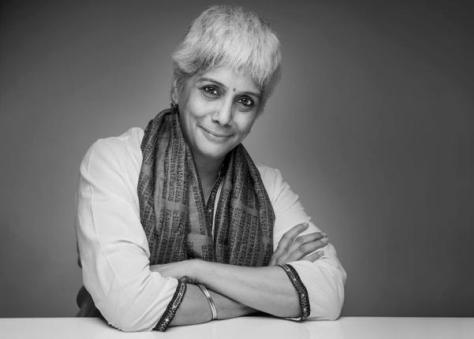 Shobha Viswanath is my publisher at Karadi Tales in India. She is also my senior editor and a writer herself. Shobha is also Farmer Falgu’s big fan.
Shobha Viswanath is my publisher at Karadi Tales in India. She is also my senior editor and a writer herself. Shobha is also Farmer Falgu’s big fan.
As a writer it is a great thing if your publisher loves your character as much as you do. She is the main reason why Farmer Falgu has packed his bags and prepared his bullock cart and is now off to Japan and France to meet the children there.
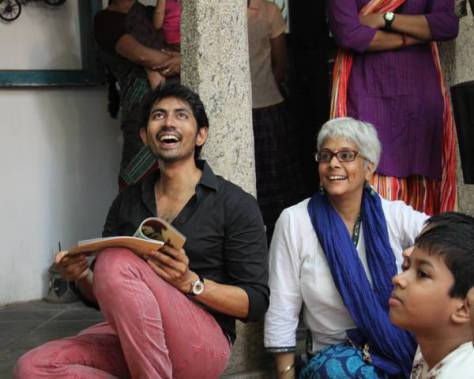 Here she is enjoying the story along with the audience…
Here she is enjoying the story along with the audience…I met Shobha 2-3 years ago when I visited Chennai before Farmer Falgu when came out. Then I met her again when we were preparing for the launch of Farmer Falgu Goes on a Trip. She is everything you’d want your editor and publisher to be – funny, encouraging, determined and absolutely positive. I’m proud and ever so grateful that Farmer Falgu and I found a great home at Karadi Tales, which is an independent publisher in India, making forays into the world market.
Karadi Tales is primarily a picture-book and audio-book publisher – I love their songs and readings – my nephew has a stack of them and we listen to some so often that we know the words by-heart. Having said that, KT has just published a Middle-grade book too.
Shobha is passionate about contemporary books for children, that are not just traditional tales and also stories for the pleasure of reading – not just textbooks, assessment books and books with morals – which does confuse many parents in India. Read one of her candid interviews with the national daily in India.
As the final instalment of the discussion on children’s book for this week’s twitter chat, I asked Shobha the same questions I asked Sayoni Basu. And this is what she said.
1) What are the major challenges for an Indian children’s book publisher on the world stage and within India?
– India lacks crossover books – books that can travel. Most of the books that are published by Indian publishers are too contextual to India. If the books have to travel, they have to have a universal appeal.
For example, Farmer Falgu may be a farmer from India but the central crux of each story in the series reveals his resourcefulness which in turn is universal.
The language too is quite important. Colloquial words and phrases may limit potential readership.
– Indian publishers lag behind the international publishers in terms of sourcing high-quality and diverse illustrators who have a repertoire of varied styles.
– Distribution in the foreign markets has been a challenge. Several things are required of a publisher, including a strong backlist of books.
2) When you go to Bologna, what are your impressions of the market compared to Indian books?
The books that are produced abroad are higher in quality – production and illustrations.
Do we have more variety?
– No. India does not have that kind of variety.
Are Indian books lacking in any aspect?
– Indian books lack in several aspects. The Indian market is heterogeneous – books are produced to cater to people from all walks of life. In terms of quality, unfortunately, it leaves us neither here nor there.
Until about 15 years ago, folktales and mythology based stories were regurgitated, but things are turning around now.
3) What is your experience in selling rights to world markets? Does the west want to buy very traditional content? Do they want to fit inside the multicultural box or are they willing to look at contemporary stuff too?
If a book is well produced, well illustrated and the story is well told then there are takers for the book in the market. They do not want to buy only traditional content. They are willing to look at contemporary stuff as well.
4) Do you get support from international and Indian bodies to help with the costs of attending world book fairs? Is your presence imperative?
Yes, we do. Bologna supports publishers and helps them attend the fair, as does Frankfurt through their fellowships and invitational programmes. However, this support is not meant to be continuous – it is only meant to give the publisher a platform. In India, Capexil provides the publisher with the necessary support.
If the goal of a publisher is to make the book travel then their presence is imperative. Agents may not know the books as thoroughly as the publisher does.
5) Should India carve its own space in the book market and not worry about whether US and UK buy rights? What other markets are more welcoming to Indian books?
Of course, we should carve our own space in the market and not worry about the UK or the US – as long as we do not compromise on the quality of the story, illustrations or production standards.
6) Can you recommend three Indian books that any child in any part of the world should read?
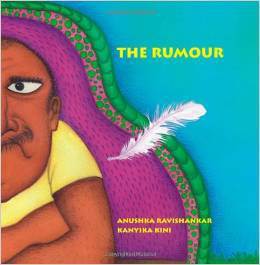 The Rumour | Written by Anushka Ravishankar and Illustrated by Kanyika Kini
The Rumour | Written by Anushka Ravishankar and Illustrated by Kanyika Kini
Farmer Falgu Goes on a Trip / Farmer Falgu Goes to the Market | Written by Chitra Soundar and Illustrated by Kanika Nair
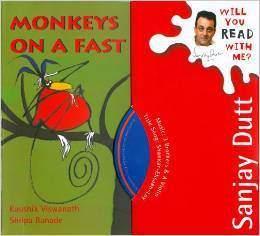 Monkeys on a Fast – Audiobook | Written by Kaushik Viswanath, Illustrated by Shilpa Ranade and Narrated by Sanjay Dutt
Monkeys on a Fast – Audiobook | Written by Kaushik Viswanath, Illustrated by Shilpa Ranade and Narrated by Sanjay Dutt
Thank you Shobha – for recommending my book and also giving candid answers to my questions. It is clear that we have a long way to go to bring Indian books to world stage but it is not hard as we think it is.
We are chatting about Indian books and their place in the world stage at 6 pm GMT today, 24th April 2015, with hashtag #storiesfromindia – Don’t miss it!!!!
April 22, 2015
Children’s Books from India – A Writer’s View
I met Devika at a talk arranged by Duckbill Books in New Delhi on the eve of Bookaroo Children’s Literature Festival, November 2014. I was inspired her passion for letting children be – let them read what they want, if they don’t want to discuss it with parents, that’s fine, she said.
Then I met her two days later again at the Duckbill breakfast and we’ve been in touch via social media. When I started discussing books from India, Devika was my first choice for an opinion on reading by children and writing for children in India.
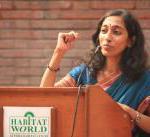 Dr. Devika Rangachari has won several awards for her children’s writing. Her book, Growing Up (Children’s Book Trust, 2000) was on the Honour List of the International Board on Books for Young People (IBBY) in 2002.
Dr. Devika Rangachari has won several awards for her children’s writing. Her book, Growing Up (Children’s Book Trust, 2000) was on the Honour List of the International Board on Books for Young People (IBBY) in 2002.
Here is our discussion on writing for children.
1. What books did you read growing up? What do you think are the big differences between the books of then to now?
I read anything and everything that I could lay my hands on when I was growing up. Among my favourites were Enid Blyton and Elinor M. Brent-Dyer; later, Agatha Christie, P.G. Wodehouse and A.J. Cronin. I remember reading several Russian folktale collections as well. Indian books hardly featured in my scheme of things.
I think a significant difference between the books of then and now relates to themes.
Contemporary young adult books, for instance, focus on topics that might earlier have been considered unsuitable reading matter for children/ adolescents and would, at best, have been treated with coyness. The globalisation of literature has also played a large part in this change.
2. As a writer, how do you choose a subject or a theme for your books? Do you have a specific reader in mind? Is that reader Indian? Do you think about an international audience when you write the book?
As I am a historian, I enjoy writing historical fiction based on my research on women in early medieval India who remain invisible in the mainstream historical narrative. Through my books, I hope to counter any incipient gender bias at an early stage and make my readers aware of extraordinary women in history who do not otherwise feature in their textbooks. I don’t really have a specific reader of a particular nationality in mind, although my characters are always Indian.
If I have written it well, the book can be enjoyed by anyone anywhere.
3. Do you go into schools and the community to meet your readers? What do they tell you about today’s books and what they are reading?
Some of my publishers send me on regular school visits so that I can interact with my target audience. What is always apparent to me is that children do read despite all the naysayers and prophets of doom—and despite all the competing distractions available to them.
In addition, their reading is seamless in that they don’t particularly focus on culture-specific books but are eager to read books that emanate from anywhere in the world. International publishing phenomena are equally popular here.
Of course, there is a huge discrepancy between the reading skills and choices of children who attend private, English-medium schools and have easy access to books, and their vernacular-speaking counterparts who constitute the majority.
4. Do you wish your book would be published in the UK and US and be considered for prizes like the Carnegie?
Yes, it would be great if my books were to be published in the US and UK, and compete for the Carnegie and other prestigious writing awards. At present, there is a dearth of awards in India instituted to identify and commend the best in children’s writing.
5. What support would you like from the bookshops in India?
It would help enormously if they could display/ promote children’s books by Indian authors in a prominent manner instead of shoving them away into inaccessible, dingy corners that is largely the norm. So while one could literally stumble over stacks of Rick Riordan, for instance, one would be hard put to even locate one’s book in the average bookstore!
6. And lastly can you tell us three books from India that every child in every country should read?
The Grasshopper’s Run by Siddhartha Sarma
Swami and Friends by R K Narayan
and of course Queen of Ice by Devika Rangachari
If you have a view and you want to discuss, join me on Twitter on 24th Apr 2015 (Friday) at 6 pm GMT with hashtag #storiesfromIndia



